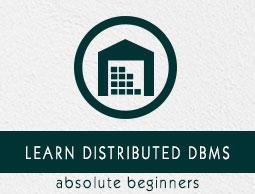Distributed DBMS - Distributed Databases
This chapter introduces the concept of DDBMS. In a distributed database, there are a number of databases that may be geographically distributed all over the world. A distributed DBMS manages the distributed database in a manner so that it appears as one single database to users. In the later part of the chapter, we go on to study the factors that lead to distributed databases, its advantages and disadvantages.
A distributed database is a collection of multiple interconnected databases, which are spread physically across various locations that communicate via a computer network.
Features
Databases in the collection are logically interrelated with each other. Often they represent a single logical database.
Data is physically stored across multiple sites. Data in each site can be managed by a DBMS independent of the other sites.
The processors in the sites are connected via a network. They do not have any multiprocessor configuration.
A distributed database is not a loosely connected file system.
A distributed database incorporates transaction processing, but it is not synonymous with a transaction processing system.
Distributed Database Management System
A distributed database management system (DDBMS) is a centralized software system that manages a distributed database in a manner as if it were all stored in a single location.
Features
It is used to create, retrieve, update and delete distributed databases.
It synchronizes the database periodically and provides access mechanisms by the virtue of which the distribution becomes transparent to the users.
It ensures that the data modified at any site is universally updated.
It is used in application areas where large volumes of data are processed and accessed by numerous users simultaneously.
It is designed for heterogeneous database platforms.
It maintains confidentiality and data integrity of the databases.
Factors Encouraging DDBMS
The following factors encourage moving over to DDBMS −
Distributed Nature of Organizational Units − Most organizations in the current times are subdivided into multiple units that are physically distributed over the globe. Each unit requires its own set of local data. Thus, the overall database of the organization becomes distributed.
Need for Sharing of Data − The multiple organizational units often need to communicate with each other and share their data and resources. This demands common databases or replicated databases that should be used in a synchronized manner.
Support for Both OLTP and OLAP − Online Transaction Processing (OLTP) and Online Analytical Processing (OLAP) work upon diversified systems which may have common data. Distributed database systems aid both these processing by providing synchronized data.
Database Recovery − One of the common techniques used in DDBMS is replication of data across different sites. Replication of data automatically helps in data recovery if database in any site is damaged. Users can access data from other sites while the damaged site is being reconstructed. Thus, database failure may become almost inconspicuous to users.
Support for Multiple Application Software − Most organizations use a variety of application software each with its specific database support. DDBMS provides a uniform functionality for using the same data among different platforms.
Advantages of Distributed Databases
Following are the advantages of distributed databases over centralized databases.
Modular Development − If the system needs to be expanded to new locations or new units, in centralized database systems, the action requires substantial efforts and disruption in the existing functioning. However, in distributed databases, the work simply requires adding new computers and local data to the new site and finally connecting them to the distributed system, with no interruption in current functions.
More Reliable − In case of database failures, the total system of centralized databases comes to a halt. However, in distributed systems, when a component fails, the functioning of the system continues may be at a reduced performance. Hence DDBMS is more reliable.
Better Response − If data is distributed in an efficient manner, then user requests can be met from local data itself, thus providing faster response. On the other hand, in centralized systems, all queries have to pass through the central computer for processing, which increases the response time.
Lower Communication Cost − In distributed database systems, if data is located locally where it is mostly used, then the communication costs for data manipulation can be minimized. This is not feasible in centralized systems.
Adversities of Distributed Databases
Following are some of the adversities associated with distributed databases.
Need for complex and expensive software − DDBMS demands complex and often expensive software to provide data transparency and co-ordination across the several sites.
Processing overhead − Even simple operations may require a large number of communications and additional calculations to provide uniformity in data across the sites.
Data integrity − The need for updating data in multiple sites pose problems of data integrity.
Overheads for improper data distribution − Responsiveness of queries is largely dependent upon proper data distribution. Improper data distribution often leads to very slow response to user requests.


